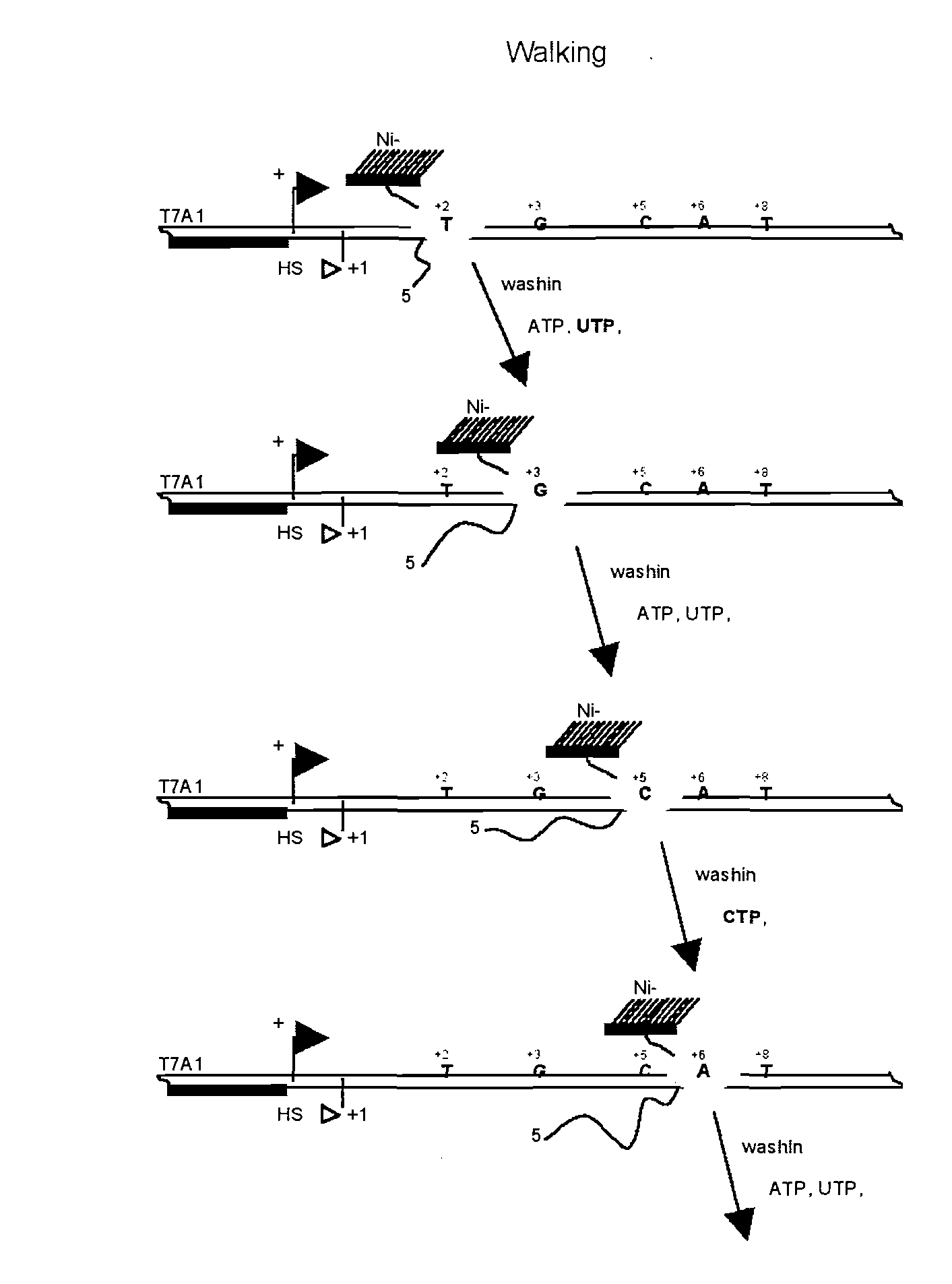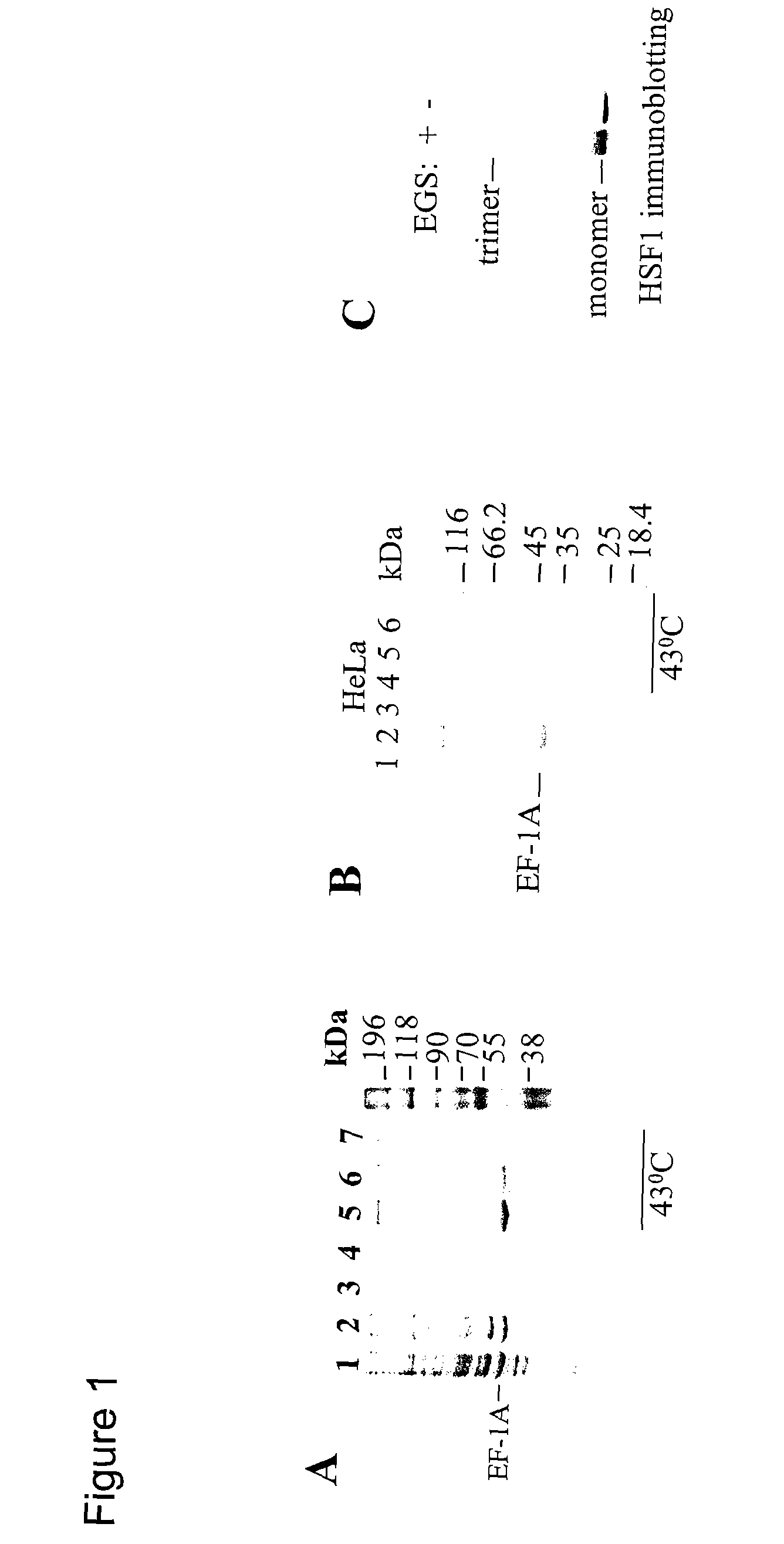Heat shock RNA and its use in activation of heat shock transcription factor and treatment of cancer, inflammation, ischemia, neurodegeneration, age-related diseases, HIV infection, deafness, and related disorders
a transcription factor and heat shock technology, applied in the field of new rna, can solve the problems of inability to rule out the existence of a positive regulation of hsf activity, the functional significance of this phenomenon is still unknown, and the effect of increasing the sensitivity of cells
- Summary
- Abstract
- Description
- Claims
- Application Information
AI Technical Summary
Benefits of technology
Problems solved by technology
Method used
Image
Examples
example 1
Identification of eEF1A as HSF-Associated Factor that Stimulates its Activation
[0240] To identify putative auxiliary factors involved in the activation of HSF1 in the lysate of heat shocked cells, the present inventors looked at proteins from whole cell lysates retained on covalently immobilized HSF1. Mouse HSF1 was expressed in E. coli as a fusion protein with GST (glutathione-S-transferase). Induction of GST-HSF1 synthesis was performed at 28° C. and care was taken not to exceed an HSF concentration of 0.5 mg / ml during purification so as to minimize spontaneous trimerization. No trimers were detected in our purified recombinant HSF upon examination by chemical cross-linking (FIG. 1C). Purified HSF1 was covalently attached to Sepharose beads. A polypeptide of approximately 45 kDa was retained on HSF1-Sepharose after incubation with a lysate from heat shocked, but not from untreated, BHK-21 (FIG. 1A) or HeLa cells (FIG. 1B). FIG. 1A shows fractionation of lysates of heat shocked BH...
example 2
Isolation OF HSR1 RNA and Determination of its Role in HSF1 Activation
[0248] Initial attempts to activate HSF1 with pure eEF1A isolated from rat liver or HeLa cells were unsuccessful, suggesting that the eEF1A-fraction eluted from HSF-Sepharose contained one or more additional unidentified component(s) required for HSF1 activation. Since eEF1A forms a complex with aminoacyl-tRNA in vivo, this interaction was evaluated for its role in activating HSF1. As shown in FIG. 4A, HSF1 binding to DNA was strongly inhibited in vitro by pre-incubation of whole cell BHK lysate with ribonuclease A (RNAseA). The effect was specific, since addition of excess tRNA prior to the ribonuclease treatment protected the HSF activity. The lysate (10 μg of total protein) was treated with 500 ng RNase A for 1 hour at 37° C. with or without excess tRNA. The amount of HSF1 in each lane was monitored by immunoblotting as shown in the lower panel of FIG. 4A. Similar results were obtained using micrococcal nuclea...
example 3
Cloning, Expression and Functional Analysis of HSR1
[0253] cDNAs of HSR1 were cloned from both HeLa and BHK cells (see Methods), and the coding strand was identified in a functional assay (FIG. 5A). As shown in the upper panel of FIG. 5A, the sense (T3) and antisense (T7) HSR1s were transcribed in vitro by T3 and T7 RNA polymerases, respectively, from PCR fragments carrying T3 or T7 promoters on each side of HSR1. The resulting synthetic RNAs were tested in the minimal HSF1 activating system (FIG. 5A, lower panel). For the reconstitution experiment shown in FIG. 5A, recombinant mouse HSF1 was used along with eEF1A purified from rat liver (as described above). HSR1 isolated from heat-shocked BHK or HeLa cells (lanes 7, 8) and HSR1-T3 (lane 10) activated HSF when added together with purified eEF1A. However, neither component alone was capable of activating HSF1 (lanes 2-6). The slight stimulating effect of isolated eEF1A (lane 2) on HSF1 activation results from the residual amount of ...
PUM
| Property | Measurement | Unit |
|---|---|---|
| Fraction | aaaaa | aaaaa |
| Temperature | aaaaa | aaaaa |
| Sensitivity | aaaaa | aaaaa |
Abstract
Description
Claims
Application Information
 Login to View More
Login to View More - R&D
- Intellectual Property
- Life Sciences
- Materials
- Tech Scout
- Unparalleled Data Quality
- Higher Quality Content
- 60% Fewer Hallucinations
Browse by: Latest US Patents, China's latest patents, Technical Efficacy Thesaurus, Application Domain, Technology Topic, Popular Technical Reports.
© 2025 PatSnap. All rights reserved.Legal|Privacy policy|Modern Slavery Act Transparency Statement|Sitemap|About US| Contact US: help@patsnap.com



